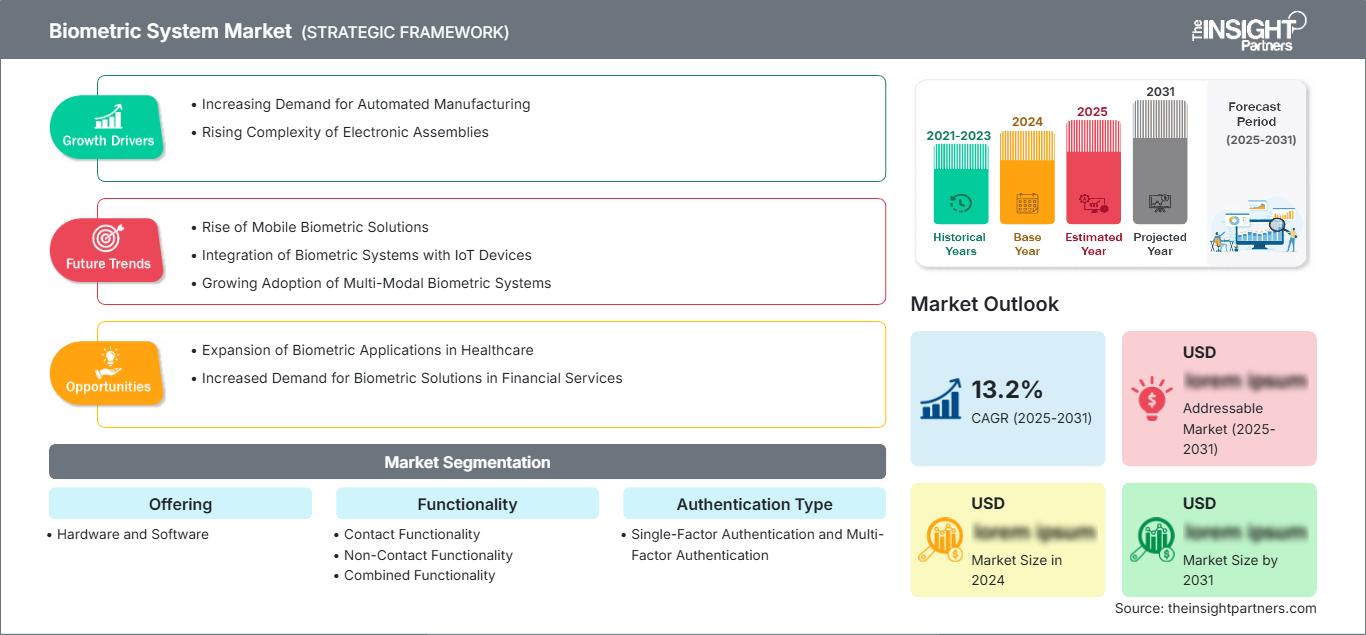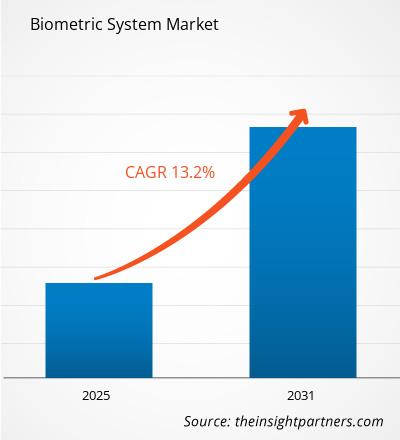页面已更新 :
Jan 2025
预计生物识别系统市场在 2025 年至 2031 年期间的复合年增长率为 13.2%,市场规模将从 2024 年的 XX 百万美元扩大到 2031 年的 XX 百万美元。
该报告按产品(硬件和软件)、功能(接触功能、非接触功能和组合功能)、身份验证类型(单因素身份验证和多因素身份验证)、最终用户(BFSI、政府、军事和国防、消费电子产品、医疗保健、汽车等)细分。全球分析进一步细分为区域和主要国家。该报告以美元提供上述分析和细分的价值。
报告目的
Insight Partners 撰写的《生物识别系统市场》报告旨在描述当前形势和未来增长、主要驱动因素、挑战和机遇。这将为各种商业利益相关者提供见解,例如:
- 技术提供商/制造商:了解不断变化的市场动态并了解潜在的增长机会,使他们能够做出明智的战略决策。
- 投资者:对市场增长率、市场财务预测和整个价值链中存在的机会进行全面的趋势分析。
- 监管机构:规范市场政策和警察活动,旨在最大限度地减少滥用,维护投资者的信任和信心,维护市场的完整性和稳定性。
生物识别系统市场细分产品
- 硬件和软件
功能
- 接触式功能
- 非接触式功能
- 组合功能
身份验证类型
- 单因素身份验证和多因素身份验证
最终用户
- 金融、金融服务和保险业
- 政府
- 军事与国防
- 消费电子产品
- 医疗保健
- 汽车
自定义此报告以满足您的要求
您将免费获得任何报告的定制,包括本报告的部分内容,或国家级分析、Excel 数据包,以及为初创企业和大学提供超值优惠和折扣
生物识别系统市场: 战略洞察

- 获取本报告的主要市场趋势。这个免费样本将包括数据分析,从市场趋势到估计和预测。
生物识别系统市场增长动力
- 自动化制造需求不断增长:制造流程向自动化的转变是插针机市场的关键驱动力。插针机简化了装配流程,提高了生产速度和精度,并降低了人工成本。电子、汽车和工业制造等行业需要高效、精准的元件贴装,因此自动化插针机对于提高整体生产效率和装配线一致性至关重要。
- 电子组件日益复杂:随着电子元件变得越来越紧凑和复杂,对插针机等精密装配解决方案的需求也日益增长。现代电子设备需要可靠、精准的元件连接,而插针机对于满足这些需求至关重要。各行各业的电子电路板和连接器日益复杂,推动了插针式技术的应用。
生物识别系统市场未来趋势
- 移动生物识别解决方案的兴起:随着智能手机和可穿戴设备越来越多地融入生物识别身份验证功能,移动生物识别解决方案的趋势日益增强。指纹扫描仪、面部识别和语音识别现已成为许多移动设备的标配,使用户能够更轻松地安全地访问其应用程序。这一趋势不仅提高了用户的便利性,还推动了银行、电子商务和医疗保健等各个领域采用生物识别系统,移动访问在这些领域正变得至关重要。
- 生物识别系统与物联网 (IoT) 设备的集成:生物识别系统与物联网 (IoT) 的集成正在成为一种重要趋势。随着越来越多的设备实现互联,对安全身份验证方法的需求也日益增长。生物识别系统可以通过为智能家居系统、工业应用和联网汽车提供用户身份验证来增强物联网设备的安全性。这种集成预计将推动对生物识别解决方案的需求,因为用户希望确保其互联环境的安全,避免未经授权的访问。
- 多模态生物识别系统的应用日益广泛:多模态生物识别系统的应用趋势显而易见,该系统结合了两种或多种生物特征进行身份验证。通过集成指纹扫描和面部识别等不同方法,这些系统提高了准确性和安全性。这种趋势在安全性要求较高的环境中尤为重要,因为单一方法可能无法满足需求。人们日益认识到多模态系统的优势,这促使各机构投资于更复杂的生物识别解决方案。
生物识别系统市场机遇
- 生物识别应用在医疗保健领域的扩展:医疗保健行业为生物识别系统提供了重大机遇,尤其是在患者身份识别和访问控制方面。生物识别身份验证可以简化患者登记流程,降低医疗身份盗窃的风险,并确保医疗记录的安全访问。随着医疗机构致力于提升患者安全和运营效率,用于安全访问和身份验证的生物识别系统的应用预计将增长,从而创造一个利润丰厚的市场机会。
- 金融服务领域对生物识别解决方案的需求不断增长:金融服务行业越来越认识到需要采取先进的安全措施来保护敏感的客户信息并防止欺诈。语音识别和指纹扫描等生物识别身份验证方法正在被集成到银行应用程序和支付系统中,以增强安全性和客户体验。金融交易领域对生物识别解决方案日益增长的需求为技术提供商提供了一个宝贵的机会,可以开发满足该行业需求的创新解决方案。
生物识别系统市场
The Insight Partners 的分析师已详尽阐述了预测期内影响生物识别系统市场的区域趋势和因素。本节还讨论了北美、欧洲、亚太地区、中东和非洲以及南美和中美洲的生物识别系统市场细分和地域分布。
生物识别系统市场报告范围
| 报告属性 | 细节 |
|---|---|
| 市场规模 2024 | US$ XX million |
| 市场规模 2031 | US$ XX Million |
| 全球复合年增长率 (2025 - 2031) | 13.2% |
| 历史数据 | 2021-2023 |
| 预测期 | 2025-2031 |
| 涵盖的领域 |
By 产品
|
| 覆盖地区和国家 | 北美
|
| 市场领导者和主要公司简介 |
|
生物识别系统市场参与者密度:了解其对商业动态的影响
生物识别系统市场正在快速增长,这得益于终端用户需求的不断增长,而这些需求又源于消费者偏好的不断变化、技术进步以及对产品优势的认知度不断提升等因素。随着需求的增长,企业正在扩展其产品线,不断创新以满足消费者需求,并抓住新兴趋势,从而进一步推动市场增长。

- 获取 生物识别系统市场 主要参与者概述
主要卖点
- 全面覆盖:该报告全面涵盖了对生物识别系统市场的产品、服务、类型和最终用户的分析,提供了整体格局。
- 专家分析:该报告基于对行业专家和分析师的深入了解而编写。
- 最新信息:由于该报告涵盖了最新信息和数据趋势,因此确保了业务相关性。
- 定制选项:此报告可以根据特定客户要求进行定制,并恰如其分地适应业务策略。
因此,关于生物识别系统市场的研究报告可以帮助引领解码和理解行业情景和增长前景的线索。尽管可能存在一些合理的担忧,但本报告的总体优势往往大于劣势。
- 历史分析(2 年)、基准年、预测(7 年)及复合年增长率
- PEST和SWOT分析
- 市场规模、价值/数量 - 全球、区域、国家
- 行业和竞争格局
- Excel 数据集
近期报告
相关报告
客户评价
购买理由
- 明智的决策
- 了解市场动态
- 竞争分析
- 客户洞察
- 市场预测
- 风险规避
- 战略规划
- 投资论证
- 识别新兴市场
- 优化营销策略
- 提升运营效率
- 顺应监管趋势
我们的客户































87-673-9708

ISO 9001:2015



 获取免费样品 - 生物识别系统市场
获取免费样品 - 生物识别系统市场